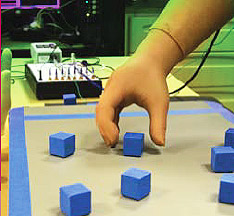Advanced Platform Technology Center
Prosthetics & Orthotics
The APT Center creates and develops innovative approaches, devices, components and materials to improve, replace or restore limb, nervous system or organ function. We employ an integrative approach that leverages clinical and scientific expertise with the core capabilities of the Center and its affiliates to pursue advanced assistive and restorative technologies that address or prevent limb loss and disability from neuromuscular, skeletal or sensory disorders. We are focusing on a number of approaches to increase independence and enhance quality of life after amputation or paralysis, including dynamic exoskeletal devices for enhanced mobility, neural implants for restoring natural sensation or muscle function, novel materials for prosthetic liners and reconfigurable walking aids for uneven surfaces or stair climbing.
Projects
Natural Sensation for Amputees
Seated Balance and Trunk Control with Implanted Neuroprostheses
Advanced Exoskeletons for Independent Mobility
Restoring Lower Limb Neural Connection (ReLLiNC) Lab
http://engineering.case.edu/rellinc
Investigators
M. Audu, PhD • H. Charkhkar, PhD • E. Graczyk, PhD • A. Hdeib, MD • S. Hnat, DEngr • C. Kelly, MD • P. Marasco, PhD • B. Odle, PhD • R. Quinn, PhD • M. Schiefer, PhD • R. Triolo, PhD • D. Tyler, PhD
Photo: From the "Natural Sensation for Amputees" project. Investigators with the APT Center are pursuing a system that provides sensory feedback for the hand via a direct interface to the residual peripheral nerve. Sensors on a prosthetic hand control stimulation to electrodes around the nerves in the remaining portion of the amputated limb, which cause the nerves to transmit impulses to the brain that are interpreted by users as tactile perceptions on their missing hands that are directly related to touch on the prosthesis.




















